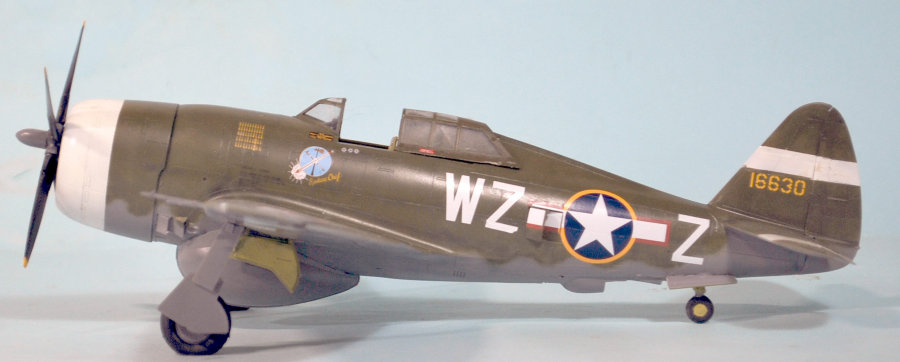
| KIT #: | DW48054 |
| PRICE: | $ |
| DECALS: | Four options |
| REVIEWER: | Tom Cleaver |
| NOTES: | Fundecals 48041 |

| HISTORY |
VIII Fighter Command’s Most Important Day:
The sky over the English Channel on July 28, 1943 was partly cloudy, an early indicator that the past week of clear weather over northwestern Europe was coming to an end. Fifteen miles west of the Dutch coast, the 40 P-47 Thunderbolts of the 78th Fighter Group eased their slow climb out of England to 23,000 feet and leveled off to cross into enemy air space ahead. Each carried a bulbous ferry tank attached to its belly. Standard Operating Procedure was for the fighters to make their entry into the enemy’s air at 29,000 feet, above the flak. But this time, 84th FS CO Major Gene Roberts was attempting something new.
Above Roberts, the 83rd Fighter Squadron flew high cover, led by Captain Charles P. London, Red One, the group’s top scorer with three. Major Harry Dayhuff, another single-victory pilot, led the 82nd Fighter Squadron in the low position.
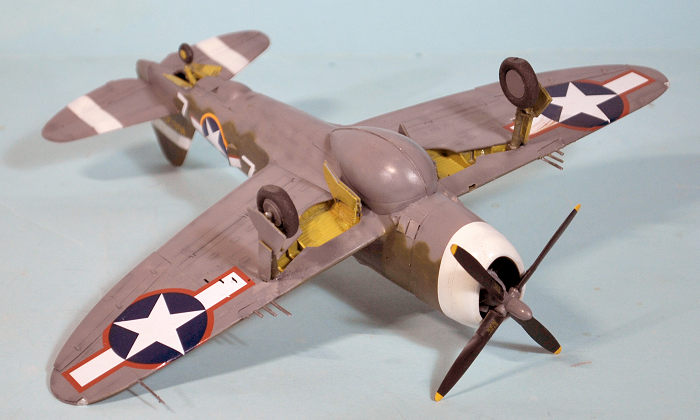 At
this altitude, Reynolds reckoned the Thunderbolts could draw the last of the
fuel from the unpressurized ferry tanks they carried. For a fighter that was
as thirsty for fuel as the P-47, every gallon mattered. The Thunderbolts
crossed the coast north of Rotterdam, high enough their sound was unheard
below. They flew past Nijmegen; pilots switched to their internal fuel tanks
as they pulled back on their sticks and followed Roberts up to 29,000 feet,
where they entered German air space over Kleve. Roberts thanked the lucky
tail wind they must have found for pushing them so far east. This was the
deepest penetration of Germany yet made by VIII Fighter Command fighters.
Only the day before, the Fourth Fighter Group had used the troublesome,
unpressurized belly tanks for the first time to set a new penetration record
, making it as far east as the German border. Roberts’ decision to delay
climbing to penetration altitude as long as possible was proven right as
American fighter pilots looked down from their cockpits on western Germany
for the first time.
At
this altitude, Reynolds reckoned the Thunderbolts could draw the last of the
fuel from the unpressurized ferry tanks they carried. For a fighter that was
as thirsty for fuel as the P-47, every gallon mattered. The Thunderbolts
crossed the coast north of Rotterdam, high enough their sound was unheard
below. They flew past Nijmegen; pilots switched to their internal fuel tanks
as they pulled back on their sticks and followed Roberts up to 29,000 feet,
where they entered German air space over Kleve. Roberts thanked the lucky
tail wind they must have found for pushing them so far east. This was the
deepest penetration of Germany yet made by VIII Fighter Command fighters.
Only the day before, the Fourth Fighter Group had used the troublesome,
unpressurized belly tanks for the first time to set a new penetration record
, making it as far east as the German border. Roberts’ decision to delay
climbing to penetration altitude as long as possible was proven right as
American fighter pilots looked down from their cockpits on western Germany
for the first time.
Good summer flying weather in the latter part of July 1943 had allowed VIII Bomber Command to mount 14 strikes ever deeper into Germany since July 24, the first sustained air offensive by the Eighth Air Force against Germany proper since the Americans had commenced operations from southern England a year earlier. Today, the “blitz” would end with three missions against the Focke-Wulf factories at Oschersleben, Warnemunde and Kassel. They were deep penetration missions beyond the range of escort fighters, and drew maximum opposition from the defenders.
As the bombers came out of the flak field over Oschwersleben, Bf-109s and Fw-190s slashed through the bomber boxes. Three Fortresses were hit, catching fire and heading down. A B-17 in the lead box took hits in an engine and dropped below, out of formation; the pilot added power to the three engines left as he desperately tried to keep up with the squadron for protection.
The bombers neared Haltern, where rocket-armed Bf-110Gs fired their missiles outside the range of the bombers’ defensive fire.
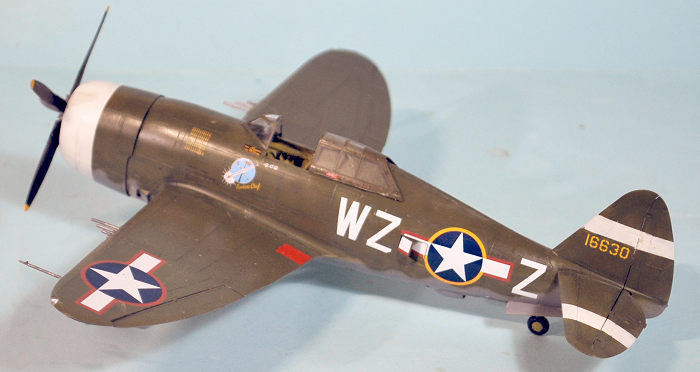 At
that moment, the 78th arrived on the scene. Roberts recalled, “We were
outnumbered by at least three-to-one odds but were able to maneuver into
attacking position with very little difficulty. The main reason for this
success was that the German fighter pilots didn’t believe we could possibly
show up that far inland and were not expecting to see a defensive force at
all.”
At
that moment, the 78th arrived on the scene. Roberts recalled, “We were
outnumbered by at least three-to-one odds but were able to maneuver into
attacking position with very little difficulty. The main reason for this
success was that the German fighter pilots didn’t believe we could possibly
show up that far inland and were not expecting to see a defensive force at
all.”
The American pilots took full advantage of German confusion. Roberts remembered: “There was one B-17 beneath the main formation, and it was being attacked by around five German fighters. The bomber was pouring smoke and appeared to be in deep trouble. From my position in the lead of the group, I dove down on the enemy fighters that were attacking the cripple. However, the Germans saw us, broke away, and dived for the ground. There wasn't much more we could do to help the crippled B-17, so I pulled up on the starboard side of the main bomber formation, about 1,000 yards out. I had only myself and my wingman, Flight Officer Glenn Koontz. We immediately saw enemy aircraft ahead of us and above the formation. I judged that there were over 100 enemy aircraft in the area, as compared with our forty.”
Roberts and Koontz came across a gaggle of Focke-Wulfs. “Dead ahead of me was a single Fw-190, at the same level as Koontz and me, about 1,000 to 1,500 yards ahead. He was racing in the same direction as the bombers so he could get ahead of them, swing around in front, and make a head-on pass. The bombers were most vulnerable from dead ahead. The Germans referred to this tactic as ‘queuing up.’”
Roberts closed to 400 yards and opened fire, hitting the German heavily with a 3-5 second burst. “The Focke-Wulf's wheels dropped and it spun down in smoke and flames.” Roberts spotted two more. “They were about 2,000 yards in front of me, heading out so they could peel off and come back through the bomber formation.” Roberts closed so fast he had to pull up and roll in on his second victim to avoid a collision. “I opened fire from dead astern. I observed several strikes and, as before, the enemy fighter billowed smoke and flames, rolled over, and spun down.” Amazingly, Roberts and Koontz were still in the middle of the action.
“After the second engagement, we were about two miles ahead of the bombers, about 500 feet above them, and still well out to their starboard side. Koontz was on my right wing. About this time, I observed a 109 on the port side and ahead of the bomber formation. I dropped below the bomber formation, crossed over to the port side, and pulled up behind him, again at full throttle.” As Roberts closed on this third enemy fighter, the 109 suddenly executed a starboard 180-degree turn to attack the bombers head on. Roberts followed as the bomber formation loomed beyond the German. “I closed to within 400 or 500 yards and opened fire. He was in a tight turn, and that required deflection shooting. My first two bursts fell away behind him, but I continued to close. I fired my third burst as he straightened out to approach the bombers.” This caught the enemy fighter from dead astern within 150 yards of the bombers; it fell over into a spin, trailing smoke and flame. While Roberts dispatched his third victory, wingman Koontz flamed the wingman Roberts had failed to spot.
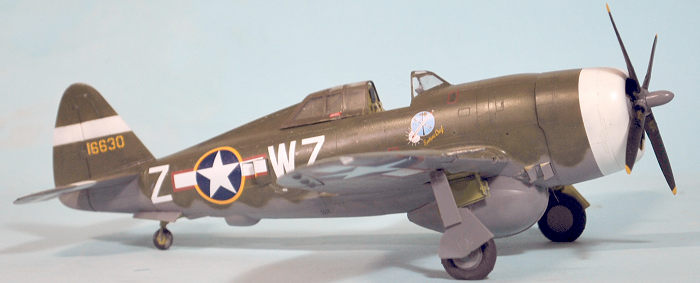 “We
were now at the same level as the bombers and approaching them from head-on.
We had no alternative but to fly between the two main formations, which were
about two miles apart. Bless their hearts, they did not fire”’ Gene Roberts
had just scored the first triple victory by an 8th Air Force fighter pilot.
“We
were now at the same level as the bombers and approaching them from head-on.
We had no alternative but to fly between the two main formations, which were
about two miles apart. Bless their hearts, they did not fire”’ Gene Roberts
had just scored the first triple victory by an 8th Air Force fighter pilot.
Group top-scorer Charles London caught two Fw-190s at 26,000 feet, flaming the leader and diving to avoid the wingman. Zooming back up to 28,000 feet he spotted a Bf-109 and hit it in its engine, setting it afire. With this victory, London was the first VIII Fighter Command ace to score all victories in the P-47.
Lieutenants Quince Brown and Peter Pompetti spotted a flight of four Bf-109s and hit them from the rear; Brown damaged the leader while Pompetti fired on the remaining three. As he made a high-G turn, five of Brown’s eight guns jammed; with only three still working, he hit the wingman on the right in the cockpit, killing the enemy pilot before breaking off to avoid a collision.
Captain Jack Price came across a flight of Fw-190s and flamed the leader. He then turned into the enemy element leader and opened fire with his wingman 2nd Lieutenant John Bertrand; each hit one of the three remaining 190s, which went down out of control.
Lt. Colonel Stone hit a Bf-109 that blew up so close that his wingman, 2nd Lieutenant Julius Maxwell, flew through the explosion. 82nd squadron commander Harry Dayhuff spotted a Bf-109; closing astern, the German blew up under his fire.
Suddenly, the sky was clear.
The battle had been an intense ten minutes. No more B-17s were lost after the 78th’s P-47s engaged. For a cost of seven P-47s lost in the melee, the 78th was credited with 16 victories. Added to the eight credited to the 56th and Fourth Groups, the day’s battles doubled VIII Fighter Command’s total score to date. Charles London had become an ace, while Gene Roberts had scored the first “triple.”
July 30, 1943 is the most important date in the history of VIII Fighter Command. For the first time, American fighters found and attacked superior enemy fighter forces over Germany, scored heavily with minimal losses, and protected the bombers. It was the sign of things to come.
| THE KIT |
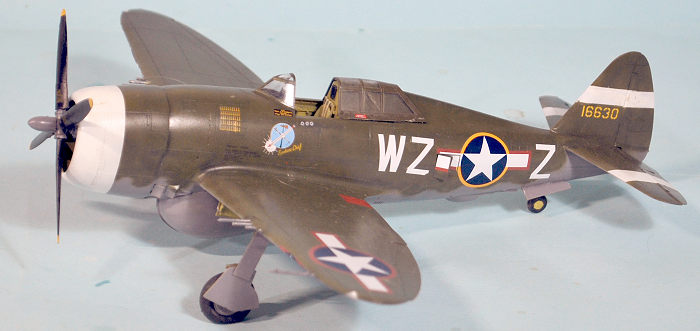 Dora
Wings’ P-47C is their second early P-47 after the P-47B. This is the first
of two P-47C releases, and covers the use of the 200-gallon ferry tank; this
is the first release by anyone of a P-47C in this configuration.
Dora
Wings’ P-47C is their second early P-47 after the P-47B. This is the first
of two P-47C releases, and covers the use of the 200-gallon ferry tank; this
is the first release by anyone of a P-47C in this configuration.
Decals proved two P-47Cs from the 56th Fighter Group and two from the 4th Fighter Group. Surprisingly there are none from the 78th, the group that put the ferry tank to its most important use.
Fortunately, Fundekals has released sheet 48041, which makes up for the lack of 78th Fighter Group options, with important new research on exactly how P-47s were marked during VIII Fighter Command’s first year. The sheet includes ten options from the 56th, 78th, 4th and 352nd Fighter Groups for he period July 1943-March 1944, for P-47Cs and early P-47Ds.
| CONSTRUCTION |
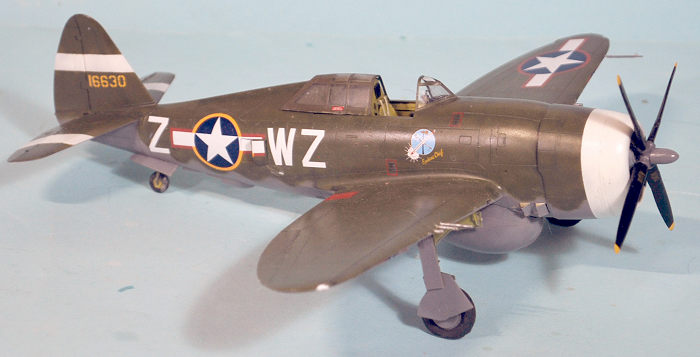 Overall,
this kit was easier to assemble than the Dora Wings P-35 and P-43 kits. It
you take care in assembly, and study the instructions to be sure you
understand what is to be done in each step, you will not need filler other
than to run some CA glue along the fuselage centerline seam..
Overall,
this kit was easier to assemble than the Dora Wings P-35 and P-43 kits. It
you take care in assembly, and study the instructions to be sure you
understand what is to be done in each step, you will not need filler other
than to run some CA glue along the fuselage centerline seam..
The main difficulty was in attaching the wings to the fuselage. I found that if I pre-fit each wing to the fuselage, then flooded the attachment area with Tamiya Extra-Thin liquid glue, and then pressed the wing to the fuselage section by section, I was able to get good fit and did not have to use any filler in the joint.
I suggest that with the wing guns, you trim the attachment point that goes in the wing flat, then glue the gun barrels into the cover part that fits into the leading edge of the wing, and then put that aside and attach the guns after you have assembled the rest of the model, you will not break off the gun barrels.
The canopy comes in the closed position. I used a Tamiya P-47 razorback sliding canopy, allowing me to pose the canopy open.
| COLORS & MARKINGS |
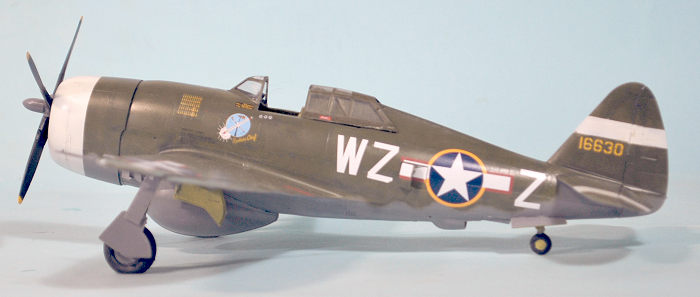 The
P-47C was painted in “green base” OD-41 Olive Drab. After painting the white
recognition markings and masking them off, I used Tamiya “Olive Drab 2"
acrylic lacquer, which is close enough to this shade. I used Gunze-Sangyo
acrylic lacquer Neutral Grey for the lower surface.
The
P-47C was painted in “green base” OD-41 Olive Drab. After painting the white
recognition markings and masking them off, I used Tamiya “Olive Drab 2"
acrylic lacquer, which is close enough to this shade. I used Gunze-Sangyo
acrylic lacquer Neutral Grey for the lower surface.
I used the Fundekals sheet to do Gene Roberts’ “Spokane Chief,” modifying the decals used for the national insignia that would have been on the airplane by med-August 1943, so I could include the markings for his three victories scored on July 28. The decals went on without problem.
I gave the model an overall coat of Micro “”Satin” clear to simulate the semi-gloss look of 78th FG P-47s which were all waxed with beeswax. I then unmasked the canopy and attached it in the open position, then attached the landing gear and propeller.
| CONCLUSIONS |
For P-47 fans, the P-47C is an important sub-type - the first to see combat. Fundekals’ sheet allows you to do important aircraft from this historic period, with more markings accuracy than ever available before.
Highly recommended for Thunderbolt fans.
1
7 October 2024
Copyright ModelingMadness.com. All rights reserved. No
reproduction in part or in whole without express permission from the editor.
If you would like your product reviewed fairly and fairly quickly, please
contact the editor or see other details in the
Note to
Contributors.